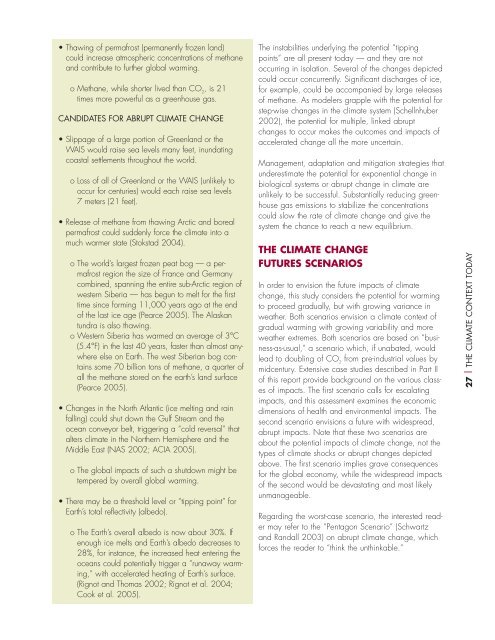Climate change futures: health, ecological and economic dimensions
Climate change futures: health, ecological and economic dimensions
Climate change futures: health, ecological and economic dimensions
Create successful ePaper yourself
Turn your PDF publications into a flip-book with our unique Google optimized e-Paper software.
• Thawing of permafrost (permanently frozen l<strong>and</strong>)<br />
could increase atmospheric concentrations of methane<br />
<strong>and</strong> contribute to further global warming.<br />
o Methane, while shorter lived than CO 2<br />
, is 21<br />
times more powerful as a greenhouse gas.<br />
CANDIDATES FOR ABRUPT CLIMATE CHANGE<br />
• Slippage of a large portion of Greenl<strong>and</strong> or the<br />
WAIS would raise sea levels many feet, inundating<br />
coastal settlements throughout the world.<br />
o Loss of all of Greenl<strong>and</strong> or the WAIS (unlikely to<br />
occur for centuries) would each raise sea levels<br />
7 meters (21 feet).<br />
• Release of methane from thawing Arctic <strong>and</strong> boreal<br />
permafrost could suddenly force the climate into a<br />
much warmer state (Stokstad 2004).<br />
o The world’s largest frozen peat bog — a permafrost<br />
region the size of France <strong>and</strong> Germany<br />
combined, spanning the entire sub-Arctic region of<br />
western Siberia — has begun to melt for the first<br />
time since forming 11,000 years ago at the end<br />
of the last ice age (Pearce 2005). The Alaskan<br />
tundra is also thawing.<br />
o Western Siberia has warmed an average of 3°C<br />
(5.4°F) in the last 40 years, faster than almost anywhere<br />
else on Earth. The west Siberian bog contains<br />
some 70 billion tons of methane, a quarter of<br />
all the methane stored on the earth’s l<strong>and</strong> surface<br />
(Pearce 2005).<br />
• Changes in the North Atlantic (ice melting <strong>and</strong> rain<br />
falling) could shut down the Gulf Stream <strong>and</strong> the<br />
ocean conveyor belt, triggering a “cold reversal” that<br />
alters climate in the Northern Hemisphere <strong>and</strong> the<br />
Middle East (NAS 2002; ACIA 2005).<br />
o The global impacts of such a shutdown might be<br />
tempered by overall global warming.<br />
• There may be a threshold level or “tipping point” for<br />
Earth’s total reflectivity (albedo).<br />
o The Earth’s overall albedo is now about 30%. If<br />
enough ice melts <strong>and</strong> Earth’s albedo decreases to<br />
28%, for instance, the increased heat entering the<br />
oceans could potentially trigger a “runaway warming,”<br />
with accelerated heating of Earth’s surface.<br />
(Rignot <strong>and</strong> Thomas 2002; Rignot et al. 2004;<br />
Cook et al. 2005).<br />
The instabilities underlying the potential “tipping<br />
points” are all present today — <strong>and</strong> they are not<br />
occurring in isolation. Several of the <strong>change</strong>s depicted<br />
could occur concurrently. Significant discharges of ice,<br />
for example, could be accompanied by large releases<br />
of methane. As modelers grapple with the potential for<br />
step-wise <strong>change</strong>s in the climate system (Schellnhuber<br />
2002), the potential for multiple, linked abrupt<br />
<strong>change</strong>s to occur makes the outcomes <strong>and</strong> impacts of<br />
accelerated <strong>change</strong> all the more uncertain.<br />
Management, adaptation <strong>and</strong> mitigation strategies that<br />
underestimate the potential for exponential <strong>change</strong> in<br />
biological systems or abrupt <strong>change</strong> in climate are<br />
unlikely to be successful. Substantially reducing greenhouse<br />
gas emissions to stabilize the concentrations<br />
could slow the rate of climate <strong>change</strong> <strong>and</strong> give the<br />
system the chance to reach a new equilibrium.<br />
THE CLIMATE CHANGE<br />
FUTURES SCENARIOS<br />
In order to envision the future impacts of climate<br />
<strong>change</strong>, this study considers the potential for warming<br />
to proceed gradually, but with growing variance in<br />
weather. Both scenarios envision a climate context of<br />
gradual warming with growing variability <strong>and</strong> more<br />
weather extremes. Both scenarios are based on “business-as-usual,”<br />
a scenario which, if unabated, would<br />
lead to doubling of CO 2<br />
from pre-industrial values by<br />
midcentury. Extensive case studies described in Part II<br />
of this report provide background on the various classes<br />
of impacts. The first scenario calls for escalating<br />
impacts, <strong>and</strong> this assessment examines the <strong>economic</strong><br />
<strong>dimensions</strong> of <strong>health</strong> <strong>and</strong> environmental impacts. The<br />
second scenario envisions a future with widespread,<br />
abrupt impacts. Note that these two scenarios are<br />
about the potential impacts of climate <strong>change</strong>, not the<br />
types of climate shocks or abrupt <strong>change</strong>s depicted<br />
above. The first scenario implies grave consequences<br />
for the global economy, while the widespread impacts<br />
of the second would be devastating <strong>and</strong> most likely<br />
unmanageable.<br />
Regarding the worst-case scenario, the interested reader<br />
may refer to the “Pentagon Scenario” (Schwartz<br />
<strong>and</strong> R<strong>and</strong>all 2003) on abrupt climate <strong>change</strong>, which<br />
forces the reader to “think the unthinkable.”<br />
27 | THE CLIMATE CONTEXT TODAY

















